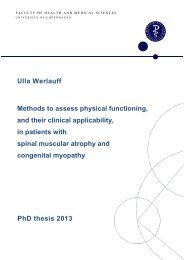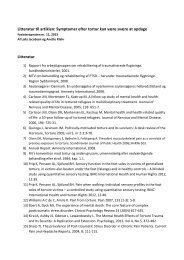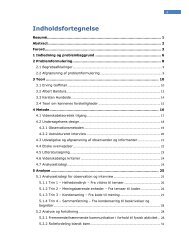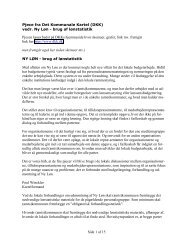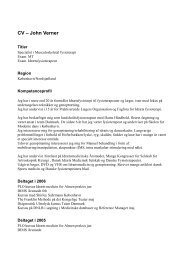Kristian Thorborg's Phd Thesis
Kristian Thorborg's Phd Thesis
Kristian Thorborg's Phd Thesis
You also want an ePaper? Increase the reach of your titles
YUMPU automatically turns print PDFs into web optimized ePapers that Google loves.
Studies have shown that patients with hip and groin pathology often report symptoms which<br />
are not restricted to the hip region.[31-34] The groin seems to be the most symptomatic<br />
region when patients report pain related to pathological conditions involving the hip<br />
joint.[31-34] These studies seem to confirm experiences from clinical practice, where<br />
patients reporting groin symptoms, often do not describe their symptoms as being located to<br />
the hip. However, as previously mentioned, the hip and groin regions have never been<br />
precisely anatomically defined and therefore merely reflect individual and cultural<br />
beliefs.[30] However, since a large majority of health care professionals and patients refer to<br />
the medial part of the hip region as the “groin”, it is problematic only labelling this region as<br />
the “hip”.<br />
Hip and/or groin pain does not refer to any specific pathology, and patients with hip and/or<br />
groin pain are therefore a large heterogeneous group of people suffering from a variety of<br />
different pathological conditions. The hip and groin region is a complex anatomical region,<br />
and validated diagnostic tools for differentiation of musculoskeletal diagnoses in this region<br />
is lacking.[35-38] Many patients with hip and/or groin pain often seem to have more than<br />
one diagnosis or clinical entity,[31,32] however, their symptoms, activity limitations and<br />
participation restrictions are often very similar.<br />
The term longstanding groin pain has previously been used in the literature,[39] but no<br />
general consensus on this definition exists. In a recent systematic review, on the effects of<br />
treatments for longstanding groin pain, longstanding groin pain was defined as groin pain of<br />
more than 6 weeks duration.[3]<br />
Outcome measures used in intervention studies involving patients with<br />
longstanding hip and/or groin pain<br />
Several systematic reviews evaluating the efficacy of different treatment modalities for<br />
patients with hip and/or groin disability, exist.[3,15-19] Numerous types of outcomes are<br />
evaluated in the individual studies. Symptoms, pain, muscle strength, return to sporting<br />
activity, and patient satisfaction (with treatment) are the most common outcomes measures<br />
10



